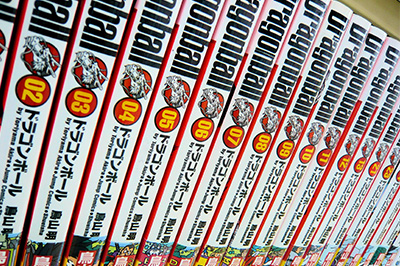 A manga school in Angoulême
A manga school in Angoulême The consecration of manga in the kingdom of comic books
In September 2015, the French capital of comic books will roll out the red carpet for manga. The Japanese school Human Academy will open its gate at the Cité internationale of Angoulême. Its goal is to train to the highly prized job of mangaka.
France, the other manga country
The news was announced on January 28th 2015, on the eve of the 41st International festival of comic books in Angoulême: in September, Japanese school Human Academy will settle in the Vaisseau Moebius of the Cité international to train the next mangakas.
Human Academy, a branch of the group Human Holdings, is a higher education institution totalizing 19 schools in Japan. Choosing France for this first outsourcing is not a coincidence: with 1,500 new publications every year, France is the second biggest manga consumer after Japan. The administrators of Human Academy hope to find among the future pupils "hybrid talents": French who fell in love with mangas but keep their "French touch". Considering how dense the Japanese manga market is, this might become a strong business asset.
Human Academy is not the first school of its kind in France: Toulouse Manga and Eurasiam in Paris had already seized the potential and impact of this graphic art in France. But the settling in Angoulême is a far more strategic move: the French (if not European) capital of comic books is a promise of an unequalled highlight on manga.
A popular culture in France
France has been enjoying mangas since the 70's under the form of... cartoons. At the time, in order to balance the insufficient Western production for children, French TV channels chose programmes from Japan called "anime". The success is as unexpected as considerable: in the January 1979 release, the magazine "Paris Match" runs the headline "Goldorak, messiah for French children!"
TV show producers found a goldmine. After that, French TV channel would broadcast "Candy Candy" (1978), "Captain Harlock" (1980), "Saint Seiya" (1988) and most of all "Dragon Ball" (1988): paper manga of this series would become one of the biggest successes in France with 250 million books sold. Today, "animes" lost ground to paper editions: they account for about 40% of comic books sold in France.
An ambitious programme
Character design, narration techniques, Japanese language and culture... those are only a few classes of the Human Academy. Training will last three years for an annual cost of 7,000 euros. Candidates to registration will have to prove at least a "baccalauréat" (A-Levels) level in arts, animation or video games. Only 40 students will be selected for the opening year 2015-2016. They will be trained by Japanese mangakas and will work in professionalizing internships in Japan. At the end of their studies, students will have the opportunity to become cartoonists, scriptwriters, graphic designers, illustrators, 2D and 3D animators, video game designers or editors. The next mangakas, trained on the banks of the Charente river, will contribute to giving the manga genre a multicultural touch.
To learn more: TV show Pixel "La France, l’autre pays du manga" (France Culture)
